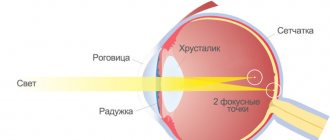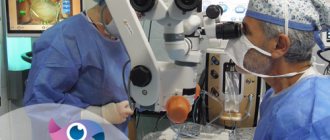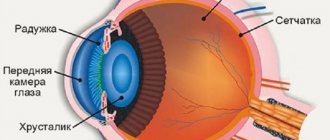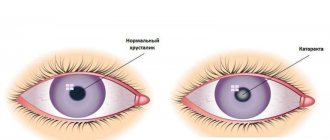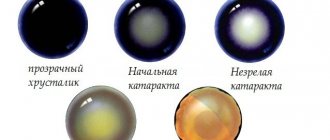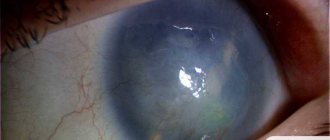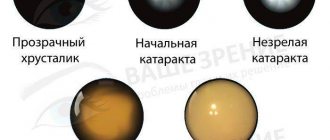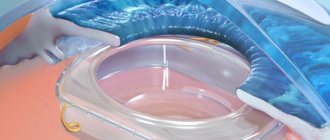Cataract (literal translation from Greek - “spray of a waterfall”, “lattice”) is a loss of transparency of the eye lens, caused by a change in the structure of the protein in its composition, and leading to various vision pathologies. Pathological processes sometimes develop rapidly, but can proceed sluggishly over a long period of time. In any case, cataracts are classified as serious diseases, and without proper attention to them, they will lead to complete or partial loss of vision. The most effective way to combat cataracts is to replace the natural lens with an artificial analogue.
Introduction
For the first time such an operation was carried out by Herold Ridley. It did not bring the desired result, just like subsequent operations. There was no suitable technique, necessary equipment, or decent lenses for transplantation. However, the idea received a powerful impetus and began to develop rapidly.
In case of cataracts, the patient and his attending physician are faced with the question: which lens is better to install: domestic or imported?
In order to correctly navigate when choosing this high-tech product, you need to have basic knowledge about it, and maximum information about manufacturers and sellers of quality lenses. The patient’s future quality of life depends on the right choice. After all, the lens should take root painlessly, last as long as possible, improve vision and not cause discomfort.
The main valuable advantages of an artificial lens are its transparency (degree of transparency) and flexibility. And:
- highest degree of compatibility with body tissues
- excellent transmission of light and color
- glare protection (anti-glare effect)
- UV protective functions
- ensuring high-quality and stable improvement of the patient’s vision
While transparency was easy for developers and manufacturers to handle right from the start, flexibility was a problem. Due to the lack of flexibility of the product, rejection, numerous inflammatory processes, and much more occurred. It was often necessary to replace the implanted lens with a new one, and the surgeon was forced to make a long incision in order to correctly place the inflexible (or poorly bendable, non-elastic) lens. It was necessary to put stitches after the operation.
Modern artificial lenses are an intraocular lens (IOL), which has the property of refracting light, creating a correct and clear image on the retina. The elasticity index is so high that the lens can be rolled into a tube. This allows the surgeon to achieve the most accurate placement of it through a microscopic incision - it straightens on its own, taking on the spherical shape of the eye. And there is no need for stitches, which significantly shortens the rehabilitation (postoperative) period. Almost immediately after the operation, the patient is able to leave the clinic independently, and the operation itself lasts about 15 minutes.
Cataract surgery: reviews
Which lens is better? To answer this question, you need to get acquainted with the reviews of people who have undergone surgery. The disease in question is considered age-related. Most often it develops in people over 40-50 years of age. The success of the operation and restoration of vision depends largely on the competent selection of intraocular lenses (hereinafter referred to as IOLs).
Patients in the reviews say that excitement and preparation for surgery is a much longer and nervous process than the lens replacement procedure itself, which lasts on average 10-15 minutes. It is done under local anesthesia. Some patients were in day care, while others left the hospital three hours later.
Almost everyone notices a noticeable improvement in their vision. In this case, we are talking not only about the clarity of the image, but also the brightness of the colors. The recovery period lasts from a week to several months. There are no contraindications based on age. There are patients who were operated on at the age of 80-86, and no complications arose.
How to choose a lens?
You need to understand that the implanted lens serves the person for the rest of his life. These are not contact lenses that can be changed depending on personal preference. You can’t go to a pharmacy and choose one model or another just because you like it.
The selection is carried out by a specialist, based on a comprehensive study of the condition of your visual system. The retina, optic nerves, vitreous body, blood vessels of the brain and eyes, and much more are tested. Complete restoration of vision after lens replacement surgery is only possible if all these components work normally. A good ophthalmologist will not guarantee a 100% restoration of visual acuity, since if there is pathology in the above organs, the improvement in vision will be partial. For example, if a patient has difficulty seeing close up, then after the operation he will still have to select appropriate glasses. But his ability to clearly see objects in the distance will be restored.
The first conclusion is that the choice of lens is influenced by the presence of pathologies in the patient before surgery.
The properties of an artificial lens are completely identical to its natural counterpart. The design has the shape of a spherical lens with a support zone (ears that fix the lens strictly in its designated place).
In the vast majority of cases, preference is given to flexible lenses made of hydrogel, silicone and acrylic. However, there are exceptional cases when the doctor is forced to implant hard lenses. These materials are of hydrocarbon origin, which means they have increased elasticity - they change shape without deforming. In addition, many flexible lenses (for example, yellow ones) protect the eyes from harmful radiation from electrical devices (computer monitors, televisions, bright sunlight). Anti-reflective properties and the ability to change curvature, adjusting to different distances, are also important.
The second conclusion is that the choice of lens is influenced by the material from which it is made.
When selecting a lens, the doctor must take into account all the anatomical features of the patient, changes and pathologies of all parts of the eye. The size of the eyeball, the degree of myopia (or farsightedness), the length of the eye muscles, etc. are taken into account. The shape, size, thickness of the selected lens, length of the supporting part, etc. depend on this.
Conclusion three – the choice of lens is influenced by the individual characteristics of the patient
Today, the market offers a huge variety of types of artificial lenses from numerous manufacturers, both domestic and foreign. And this cannot but influence our choice, greatly complicating it. Most doctors prefer American or German implants. The lens made in India is considered to be the worst. Their quality leaves much to be desired. This will be discussed in detail below.
Conclusion four: the choice of lens is influenced by the reputation of the company and the country of manufacture
Indications for surgery
Installation of an intraocular lens (abbreviated as IOL) is necessary for eye diseases accompanied by clouding of the lens (cataract), loss of the ability to focus vision at close distances (age-related farsightedness or presbyopia), eye trauma and other pathological processes. Unconditional indications for surgery include:
- cataracts, in which age-related clouding of the lens and degeneration of its tissue occurs;
- high degree of age-related farsightedness (over +6 diopters);
- congenital or age-related high myopia (over -6 diopters);
- astigmatism, in which the problem is caused by a lens that does not focus light beams;
- congenital, traumatic or postoperative absence of the lens;
- dislocation of the lens with destruction of its body.
Such an intervention can be carried out at any stage of the disease, including complete loss of vision. The only obstacles to lens replacement may be infection of the eye, extensive retinal atrophy and optic nerve dystrophy. In this case, the installation of a lens will be impractical, since other structures of the eye responsible for the perception of visual images remain non-functional.
What types of eye lenses are there and their cost?
Before you get acquainted with the advantages and disadvantages of products from global companies that produce artificial lenses, you need to form a simple idea of their types and purposes.
So, the lenses differ:
1) According to the material of manufacture:
- hard. They are used in extreme cases when there are contraindications to the use of other types. During the operation, an incision of up to 12 mm is required, followed by sutures. They were removed only after 6 months. Often the lens did not take root and caused a lot of trouble for the patient.
- soft . Thanks to their elasticity and resilience, the use of the latest technologies, it has become possible to perform seamless operations (phacoemulsification). Cases of rejection and various complications are minimized and practically absent. Both surgery and rehabilitation take significantly less time.
2) According to the shape of the lens:
- spherical. This form of IOL is characterized by uneven refraction of the light beam in its various parts. And the scattering of the light beam leads to glare and the effect of overexposure, and also deteriorates the quality of vision.
- aspherical. This shape promotes uniform refraction of light across the entire surface of the lens. This eliminates glare and glare from bright light stimuli (for example, from car headlights or street lights), especially in the dark, with maximum pupil dilation. Aspheric IOLs have better color rendering and increased contrast.
3) According to correctional possibilities:
- monofocal. Made from synthetic materials, such lenses do not have the ability to change curvature, adjusting to changing distances, as natural lenses do. Therefore, distance vision is corrected, and for working at close distances it is necessary to select appropriate glasses.
- Multifocal. The design of this type of lens uses special optics, where, depending on the distance to the object in question, different zones of the lens surface are involved. The properties of such a lens are as close as possible to the properties of a natural lens. However, the complexity of calculating these zones and the high cost of manufacturing significantly increase the cost, and, consequently, the final price of the product.
- toric. They are selected individually, based on the indications of the amount of astigmatism present. These lenses have a built-in cylinder that corrects astigmatism. After implantation of a toric lens, the patient can completely abandon glasses with cylinders. However, vision improvement occurs only in one direction - either clearly visible in the distance or close.
- multifocal toric. In addition to correcting astigmatism, such lenses improve vision at different distances - far and near. For the complexity of calculations during selection, comfort and excellent vision, the patient will have to fork out money - these models are the most expensive.
- with filters that protect the eyes from radiation. These models belong to the premium class. They contain yellow pigments that cut off blue rays from the invisible part of the light spectrum. The natural human lens has the same properties.
- phakic. When contraindications to lens replacement surgery are discovered, special overlays are used on the native lens to improve its properties. These are phakic IOLs.
- accommodating. These are monofocal lenses that can change position in the eye.
Which artificial lens manufacturer should I choose?
During surgical interventions for cataracts, doctors use various IOLs of domestic and foreign production. In most cases, ophthalmologists prefer to work with artificial lenses, which were developed in the USA and European countries. Foreign experts conducted many studies and surveys of patients, which allowed them to understand which lens is best suited for implantation. The main criteria were the elasticity of the intraocular lens and its small size. Such implants quickly “take root” after surgery, and the rehabilitation period takes very little time. Artificial lenses for cataracts, created by Russian companies, are practically not inferior to foreign ones in elasticity. But they have one significant drawback, which experts have not yet been able to correct. Domestic IOLs can distort color rendering. The occurrence of glare and glare is possible even with the implantation of an aspheric intraocular lens. It was also noted that secondary cataracts more often occur with the previous introduction of an artificial lens. The most popular IOLs today are those developed in the USA. AcrySof products are especially high quality. Another American manufacturer is the Bausch & Lomb brand.
It produces gel lenses, which, once they enter the lens capsule, take the desired position under the influence of temperature. Doctors and patients leave good reviews about IOLs from the following companies:
- Alcon (USA);
- Abbott Medical (USA);
- Medennium (USA);
- Rayner (UK);
- Staar (Switzerland).
German-made artificial lenses are highly valued. They are produced by the famous company Carl Zeiss. The Liza line of intraocular lenses has excellent characteristics. Its advantage is that it is suitable for all users, regardless of the size of their pupil. The company’s technologists also managed to develop an aspherical IOL, which is ideal for allergy sufferers and people with sensitive eyes.
American artificial lenses for eyes
Perhaps the most popular and sought-after products are produced by Alcon. It deservedly occupies a leading position in the ranking of manufacturers of intraocular lenses. Over 12 years, more than 25 million lens replacement operations have been performed worldwide using IOLs from this particular company. Doctors around the world prefer Alcon lenses.
- enVista (Bausch&Lomb
- AcrySof ReSTOR Toric (Alcon)
- AcrySof ReSTOR ASFERIC from Alcon
- AcrySof Natural
- AcrySof IQ. Special development is aimed at maximum suppression of aberrations (visual interference). The back is shaped so that light rays are focused into one narrow area of the retina. This prevents the appearance of glare, halos, etc., both in bright light and at dusk.
- AcrySof Toric
- Crystalens AO Lens
- Akreos Adapt AO (Bausch&Lomb)
Each of the models has its own advantages and features, but what is common to the entire Alcon product line are:
| pros | Minuses |
|
|
How long will an artificial lens last?
The durability and reliability of artificial lenses is mainly determined by the nature of the material from which they are made. Previously, hard drives were used for implantation. Currently, the “gold standard” is considered to be flexible IOLs made from bioinert materials that are fully compatible with body tissues. They do not cause allergic or inflammatory reactions and are not susceptible to rejection.
The basis of intraocular lenses is a polymer that is not subject to corrosion and decay, and is inert to the effects of enzymes, acids, water and other chemicals that are present in the human body.
Modern intraocular lenses do not lose their properties over time, are durable, wear-resistant and do not need to be replaced. Therefore, the shelf life of an IOL is the entire life span of a person after installation.
According to experts from Alcon (USA), during more than 50 million operations for cataract removal with IOL installation, not a single case of complications or re-implantations associated with the quality of lenses was recorded.
German lenses for eyes against cataracts
In Russia, the products of the German company ZEISS are very popular and available. A large assortment, variety of models and affordable pricing, combined with excellent quality, have brought ZEISS to a leading position in the ranking of IOL manufacturers.
The company has been producing optical instruments for more than 100 years. At the next congress of the EOCRH (cataract surgeons), the company presented its new developments - innovative lenses for cataracts - of the highest quality and excellent technical characteristics, which have not yet been seen on the IOL market.
The patented SMP (smooth micro phase) optics technology used by its specialists allows achieving ideal image quality without glare, light loss and refractive errors.
Brief overview of ZEISS IOL models 1. Multifocal lenses:
- Aspira Diffractiva from Human Optics
- AT LISA (AT LISA 809M / Acri.LISA 366D)
Pros:
- Asymmetrical distribution of light fluxes between foci, which improves the quality of vision and reduces glare
- High-tech lens surface coating ensures independence from pupil size
- the absence of sharp corners on the coating leads to negligible loss of light and a perfectly clear image
- aspherical shape, which has a beneficial effect on vision parameters
- AT LISA toric 909M
- AT LISA tri 839MP is the first trifocal lens registered with us.
Pros:
- Transplanted using the MICS method, the lens is in a cartridge, which improves the quality of vision at medium distances
- soft focusing at any distance and in any lighting
2. Monofocal lenses
- CT ASPHINA 404
- CT ASPHINA 409MP
- CT ASPHINA 603P
- CT LUCIA 601P/601PY
- ST ASPHINA 509M
- CT SPHERIS 203P (preloaded)
- AT Torbi 709M
- Oculentis Mplus (lentis ls 313)
- Diffractiva-aAY from Human Optics. Yellow lens made of hydrophilic material (acrylic). Optimal balance between focuses.
A joint product of the German company Oculentis Gmbh and the Dutch company Topcon. The only lens that corrects presbyopia. The unique innovative technology allows manufacturers to achieve maximum smoothness of the transition of optical zones. The design of the lens protects the posterior capsule of the lens from clouding.
Pros:
- complete restoration of vision at any distance
- minimum loss of photosensitivity and contrast
- no image shifts (effective fixation)
- no glare, flare, or split images
- barrier edging protects against secondary cataracts
- presence of a light filter
- the material is not rejected by the body
- The size of the pupil does not affect the properties of the lens. Already in the first hours after the operation, the patient can read, work on the computer and watch TV.
Common to all IOL models from German manufacturers are:
| pros | Minuses |
|
|
Which lens is better, American or German, for cataracts?
Some people do not quite understand the differences between American lenses and German ones:
The user received the following response from an ophthalmologist.
Although the reviews presented are not new, they are still relevant today.
So, judging by the reviews, the rating of the best lenses looks like this:
- Acrysof IQ. The average cost is 22,000 rubles.
- Human Optics PC Iol Model Aspira- aAY. The average price will be 20,000 rubles.
The list is not large, but it is represented by the highest quality and most popular lenses that are used after cataract surgery.
Which lens is better
The doctor will discuss the potential benefits of each lens with the patient and help them choose the one that best suits the patient's lifestyle and visual needs.
If surgery is performed using extracapsular extraction, rigid products are chosen. In ophthalmology clinics, phacoemulsification is used - this is a modern and popular method of treating cataracts.
The choice of artificial lens depends on the indications, anatomy and other factors that are taken into account before surgery.
Which lens is better - imported or domestic?
Imported products are of better quality. Domestic models are significantly inferior in quality to their foreign counterparts. They fall short of imported prototypes by almost 50%.
Despite the incredible cheapness of domestic lenses, it is not recommended to buy them. Western prototypes are more reliable, better quality, better correct visual perception and do not cause allergic reactions.
It is better to install an imported model, paying a little more, than to suffer later due to the complications that arise.
Manufacturers from other countries
- Hoya ISert® 251 from Hoya Surgical Optics, Japan. Pre-installed posterior chamber, unique two-piece block design provides maximum visual acuity and clarity.
| pros | Minuses |
|
|
- FineVision (PhysIOL, Belgium). Super elastic, aspherical lens, with yellow spray pigment.
| pros | Minuses |
|
|
Classification of lenses
Types of lenses:
- Anterior chamber lenses—placed over the iris, the colored part of the eye. This is not a natural physiological position, and this type is not preferred. Implanted in case of defect or damage to the posterior capsule of the lens.
- The posterior chamber lens is placed in place over the residual posterior capsule in the physiological position of the natural lens.
IOLs - monofocal, accommodating, multifocal, aspheric, toric.
Monofocal models, unlike the natural lens of the eye, restore vision at only one distance. The power is calculated in such a way that the patient does not require glasses. After lens implantation, reading glasses or bifocals will be needed, depending on the pre-existing refractive error.
Accommodating products are prescribed if the patient wishes to gain near and distance vision without wearing glasses.
Multifocal - normal vision near and far. Achieve equally good visual perception at any distance without further wearing glasses.
Flaws:
- glare;
- decreased contrast sensitivity.
Monofocal/multifocal IOLs correct only the spherical component of the eye, leaving behind the cylindrical force, which is subsequently corrected by additional prescription glasses.
Toric products correct the spherical and cylindrical components of the eye. Recommended if the patient has a high existing cylinder or astigmatism.
Aspheric IOLs are prescribed to patients over 45–50 years of age. IOL implantation allows you to achieve high contrast sensitivity, good visual acuity, and high sharpness.
Indian intraocular lenses
One of the largest manufacturers of medical products in India is Appasamy Ocular Devices Pvt. Ltd. _ Considering the large population of the country and the presence of government programs for medical support of the population, companies engaged in this area receive good profits within the country and develop successfully. More than 80% of IOLs used by ophthalmologists in the country are manufactured by specialists from this company. The process of conquering sales markets abroad is also progressing successfully. Appasamy has a lens manufacturing plant (Ellis Opthalmics) in New York.
Cataract is the most global problem in India, due to the abundance of sunlight, food culture, lifestyle, and so on.
The company's products are quite competitive, as they are a cheap alternative to expensive global brands. Regularly exhibits its products at European and American exhibitions, receiving in return tax reductions, which also has a positive effect on the price of the product.
- OcuFlex . There are two varieties in production F6125SQY and YPH55
- Acryfold 502 . It is registered in Russia and recommended for use. After implementation, it shows good visual results. Complications in the postoperative period and during the procedure itself are minor. Supplied in a preservative liquid in a glass bottle. The kit includes a cartridge and an injector.
It is difficult to give an unambiguous assessment of eye lenses from Indian manufacturers:
| pros | Minuses |
|
|
Reviews of Indian eye lenses:
Russian lenses for eyes
How to choose a lens for the eye, whose brand and price is better? What types of Russian-made lenses are there? When replacing the lens of the eye, which is better, ours or an imported one? This question cannot but arise in the mind of a reasonable person. However, the answer to this is not as obvious as it might seem at first glance. Well-rooted stereotypes hinder the promotion and popularization of products of Russian manufacturers. This fully applies to the production of eye lenses.
Here is a clear example of how the lack of a legislative framework, the ability to organize and develop production in our conditions, and the lack of support from domestic consumers prevented a Russian manufacturer from launching the production of MIOL Record-3 trifocal lenses, which at that time had no analogues in the world. In 2000, she registered this new product for launch into production. It allowed the patient, after implantation, to see equally well at any distance, without additional devices. However, the only mold supplier went bankrupt and a replacement could not be found. Having not received government support for purchasing molds abroad, the company curtailed production, and the innovative idea was immediately picked up by Western competitors. They successfully established the production and sale of this unique product. And now the Russian consumer is forced to purchase these lenses from foreign manufacturers, at a very high price.
Domestic eye lenses reviews:
So, there are three Russian manufacturers of intraocular optics:
- NPP Reper-NN
- LLC "Latan" 40 IOL models.
- CJSC NPO ICE
| pros | Minuses |
|
|
Japanese lenses
The largest company in Japan has become a global corporation producing high-quality optics. ISert® 251 from HOYA CORPORATION has no analogues. The uniqueness of the IOL lies in its innovative monoblock two-piece design.
| pros | Minuses |
| reliable fixation; prevents haptics from sticking to the optical part; a sharp edge reduces the risk of developing secondary cataracts; reliable delivery into a capsule bag; sterility, eliminates contact with the product. | low availability; high price. |
Prices for popular IOL models
By country:
| A country | Lower price limit | Upper price limit |
| USA | RUR 9,900 | RUB 94,000 |
| Great Britain | RUB 18,000 | RUB 85,000 |
| Germany | RUB 9,000 | RUB 95,000 |
| Russia | RUB 7,000 | |
| India | RUB 14,000 |
By manufacturer:
| "Acrysof" Alcon (USA) | RUR 9,900 |
| "Acrysof" Natural Alcon (USA) | RUB 14,000 |
| "Acrysof" IQ Alcon (USA) monoblock. | RUB 18,000 |
| "Acrysof" IQ Toric Alcon (USA | RUR 38,000 |
| Acrysof IQ PanOptix | RUB 89,900 |
| "Acrysof" ReSTOR Alcon (USA) | RUB 59,000 |
| "Acrysof" ReSTOR Toric Alcon | RUB 94,000 |
| Tecnis monofocal, Abbott Medical Optics (USA) | RUB 18,000 |
| Tecnis toric, f. Abbott Medical Optics (USA) | RUB 53,000 |
| Tecnis Multifocal, f. Abbott Medical Optics (USA) | RUB 69,000 |
| Aspira®-aAY HumanOptics (Germany) | RUB 9,000 |
| TORICA®-aAY HumanOptics (Germany) | RUR 21,000 |
| DIFFRACTIVA®-aAY HumanOptics (Germany) | RUR 36,000 |
| Carl Zeiss Asphina 404 | RUR 34,900 |
| CT Asphina 409M Carl Zeiss (Germany) | RUB 18,000 |
| CT Asphina 509M Carl Zeiss (Germany) | RUB 19,900 |
| AT LISA 809M Carl Zeiss (Germany) | RUB 55,000 |
| AT LISA tri 839MP Carl Zeiss (Germany) | RUB 95,000 |
| Rayner SuperFlex Aspheric (UK) | RUB 19,900 |
| Rayner C-Flex (UK) | RUB 18,000 |
| Rayner Toric (UK) | RUR 23,000 |
| Rayner multifocal (UK) | RUR 39,000 |
| Rayner M-Flex Toric (UK) | RUB 85,000 |
| SPK (PSP-3) (Russia) | RUB 7,000 |
| Acryfold 601 India | RUB 14,000 |
